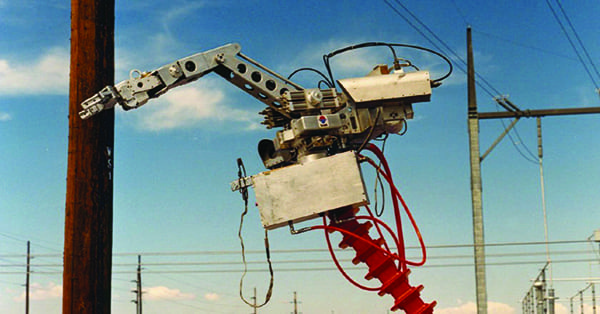Advanced Digital Technology Offers Utilities Profound Changes
Advanced digital technologies, including robotics, artificial intelligence, and machine learning, are transforming the way electric power companies do business, in ways that benefit the companies and their customers, often largely under the radar.
In late July, the worldwide consulting firm Accenture and Japan’s Kansai Electric Power Co. (KEPCO) announced a joint venture to further imbed digital technologies, including artificial intelligence (AI) and machine learning (ML), into the utility’s fundamental operational processes. The two firms have formed a joint venture called K4 Digital, which they tout in a news release as building “a new analytics solutions platform to render maintenance of power station and grid equipment even more efficient and accurate.”
The importance of the joint venture is not that it’s novel, but that it is something many electric utilities around the world, including the U.S., are focusing on, without much hyperbole but with much effort. Remember the “smart grid”? Replace that with the smart utility, which appears to offer even more benefits to companies and their customers.
The current efforts include robotics, starting with drone technology, AI based on deep analytics of system behavior, and machine learning, which may be the way to tie them all together. John Simmins (Figure 1), the Electric Power Research Institute’s (EPRI’s) digital technology guru working from EPRI’s Knoxville, Tennessee, facility, told POWER, “It’s interesting how these technologies complement each other. The people working on them have different skill sets, but the overlap is where the fun stuff is going to be.”
Robotics
The place to start is with drones, autonomous and semi-autonomous aircraft. For those old enough to remember, flying radio-controlled model airplanes was once a widespread hobby. But drones are an order of magnitude more important, smarter, and more powerful. The military developed the technology with private-sector contractors. Now, with rules promulgated by the Federal Aviation Administration, drones—unmanned aerial vehicles (UAVs)—are available for civilian use.
They have found wide use in the electric utility industry. Among those uses: inspecting transmission and distribution lines and towers, wind turbines, and boilers; roof appraisals; bypassing rugged or unstable terrain for various reasons; storm damage assessment; and detecting natural gas pipeline leaks.
In a recent POWER article, Mike Danielak of Skyward, a Verizon company, said, “In addition to the safety benefits, drones offer significant cost savings. Manned aircraft for line inspections typically cost between $1,000 and $2,000 per hour, while drones can cost as little as $200 to $300 per hour to do the work while collecting even more data.” One recent estimate said, “The global revenue for all drones and robotics for transmission and distribution system (T&D) segments is expected to reach approximately $13.2 billion by 2026.”
Drones are one of the more basic uses of a larger category of robotics. Wikipedia’s definition of robots is: “A robot is a machine—especially one programmable by a computer—capable of carrying out a complex series of actions automatically. Robots can be guided by an external control device or the control may be embedded within. Robots may be constructed to take on human form but most robots are machines designed to perform a task with no regard to how they look.”
Robots have been a fixture in business—particularly manufacturing—for decades. They have been widely used in the automobile industry to replace bespoke (hand-built) cars and trucks. A Navigant Research analyst recently wrote, “Today, these robotics technologies have penetrated the utility industry, providing utilities with innovative options for improving operations.”
In addition to drones, electric companies are beginning to use robotic manipulators on energized high-voltage T&D lines. Working with EPRI, Southwest Research Institute, AB Chance, and Exelon’s Philadelphia Electric, Kraft TeleRobotics has developed a robotics system called TOMCAT (Figure 2) that can work with live lines in excess of a million volts. The company says, “With the lineman operator located in the safety and comfort of an enclosed control van, the Kraft system facilitates live line work under a variety of conditions which make it difficult, unsafe, or impossible for crews to work.”
 |
| 2. TOMCAT. The TOMCAT robotics system can work on live electric lines in excess of a million volts. Courtesy: Kraft TeleRobotics |
Artificial Intelligence
Closely associated with robotics is AI. Utility Dive late last year reported, “AI uses are quickly moving beyond abstract exhibitions and film villains. Machines can now respond to voice commands, drive cars, record movies and music, and make financial transactions.” Franklin Wolfe of Harvard said, “Although AI is in its early stages of implementation, it is poised to revolutionize the way we produce, transmit, and consume energy.”
World War II cryptanalyst and computer genius Alan Turing in 1950 came up with the concept of AI. He proposed an experiment, called the Turing Test, to define how a machine is intelligent. He offered that if a human questioner could not tell it apart, through conversation, from a human being, the machine was intelligent. “Alexa, who was Alan Turing?”
Modern AI for utilities is able to take enormous amounts of often disparate and diffuse data and use it to make useful predictions to guide operations. Writing in POWER last June, Al Khotanzad of Drillinginfo outlined how AI can aid in developing more-accurate electricity load forecasts. “The relationship between load and temperature is quite nonlinear and complex,” he wrote. He added that among many load-forecasting technologies available, “the more recent approaches that utilize [AI] and [ML] technologies have proven to be more accurate than others.”
According to Khotanzad, “Artificial neural network (ANN) technology has been the most successful methodology for load forecasting. ANNs are computer models inspired by the way the human brain is organized and functions. They are made up of a large number of interconnected elementary processing elements (neurons) that communicate with each other. While little processing is performed by each single neuron, the aggregation of their activity results in an intelligent outcome.”
Machine Learning
ML is a closely linked subset of AI. A standard definition is that ML uses statistical data from performance to inform computers how to get progressively smarter and more accurate. AI and computer gaming pioneer Arthur Lee Samuel, who died in 1990 at the age of 89, coined the term in 1959. He invented the “Samuel Checkers-Playing Program,” which learned from its interactive experience to improve its play. It ran on an IBM mainframe computer.
An article in Internet of Business in January noted that ML is not new to the utility business, particularly on pricing forecasts, customer segmentation, analysis of anomalies, predictive maintenance, and fraud detection. Stuart Ravens, a Navigant analyst, said, “The utilities industry is already using self-learning algorithms, particularly in the field of asset monitoring and predictive maintenance, and several reasons suggest the use of machine learning will expand to many more use cases and its adoption will accelerate.”
The Internet of Business article suggested that ML “could be of particular interest to utilities struggling to integrate renewable energy with more traditional sources of power supply. Wind and solar power is erratic—it’s hard to predict how much energy a utility can harness this way unless it knows exactly how long and how hard the wind will blow and/or the sun will shine.”
That’s what California-based Concentric Power is working on. The company integrates small gas-fired internal combustion generation with onsite chillers to serve agriculture customers who have wind and solar generation microgrids. Concentric is developing AI and ML algorithms to figure out, CEO Brian Curtis (Figure 3) told POWER, the “next generation of distributed energy.”
In the renewable world that he is convinced is coming, Curtis said, “A lot of grid support is going to be needed.” So, Concentric is using advanced analytics, AI, and ML to optimize internal combustion engines, the solar and wind generation, and his customers’ need for refrigeration, along with the demands of the distribution grid. “We are looking at being able to take excess power and dispatch it into the grid, and provide capacity, frequency, and voltage support to the grid.
“A lot of people talk about machine learning and AI,” he said, “but what they are really talking about is plain old automation. We literally have machines learning on their own, learning what’s going on in the grid. Once we have a critical mass of distributed energy resources, we can start to aggregate all of that, and then monetize it in different ways.” That will also be the case for battery technologies, said Curtis, as they replace the fossil backup power he is providing.
Another place ML can play a big role, according to Ben Packer at Utilities Blog, is figuring out how electric vehicles (EVs) fit into the grid. “Utilities have a huge incentive to know when electric vehicles—the largest home appliances ever—are plugged into the grid,” he said. “In the intermediate term, it’s a customer engagement opportunity: EV detection would allow utilities to suggest time-of-use rates and encourage overnight charging. Down the road, electric cars could also prove to be an important demand response resource.”
Where is all this going? EPRI’s Simmins offers some suggestions. For drone technology, applications of AI and ML could help understand what the drones see when they fly over a site. Getting data from drone images is easy, he said, but analyzing it is not. “You can’t look at 2.5 million pictures. You have got to dump it into a program and an algorithm. That’s where I’m seeing the initial forays into AI and ML. How do we model the grid—predict behavior—particularly with distributed generation? It’s becoming very complicated and we may need to turn it over to a machine at some point.”
The issue of distributed generation and the interface with markets is particularly gnarly. Simmins asked, “When we look at several hundred thousand people generating electricity and we can’t use it all, whom do you buy it from fairly?” That’s where it might make sense for a neural network to figure it out. “Let it sit there and observe decisions made.”
But there’s a down side to this, noted Simmins. “All of this is fraught with concerns about privacy, security.” Figuring out that conundrum is a priority for EPRI. He ended the conversation with this observation: “One futurist said that anything you read as science fiction as a kid, it’s going to happen.” ■
—Kennedy Maize is a long-time energy journalist and frequent contributor to POWER.

